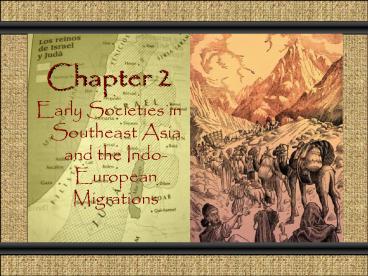Early Societies in Southeast Asia and the IndoEuropean Migrations - PowerPoint PPT Presentation
1 / 27
Title:
Early Societies in Southeast Asia and the IndoEuropean Migrations
Description:
Cuneiform: 'wedge-shaped' Preservation of documents on clay ... Simpler alternative to cuneiform. Spread of literacy. Indo-European Migrations ... – PowerPoint PPT presentation
Number of Views:278
Avg rating:3.0/5.0
Title: Early Societies in Southeast Asia and the IndoEuropean Migrations
1
Chapter 2 Early Societies in Southeast Asia and
the Indo-European Migrations
2
Civilization Defined
- Urban
- Political/military system
- Social stratification
- Economic specialization
- Religion
- Communications
- Higher Culture
3
Civilization and the Means of Production
- Essential element concentration of wealth
- Agriculture
- Control over natural resources
- Development of ancient civilization
- not hunter-gatherer economics
4
Origins and Spread of Agriculture
5
Mesopotamia
- Between the Rivers
- Tigris and Euphrates
- Contemporary Iran, Iraq
- Cultural continuum of fertile crescent
6
The Wealth of the Rivers
- Nutrient-rich silt
- Key irrigation
- Necessity of coordinated efforts
- Promoted development of local governments
- City-states
- Sumer begins small-scale irrigation 6000 BCE
- By 5000 BCE, complex irrigation networks
- Population reaches 100,000 by 3000 BCE
- Attracts Semitic migrants, influences culture
7
Sumerian City-States
- Cities appear 4000 BCE
- Dominate region from 3200-2350 BCE
- Ur (home of Abraham, see Genesis 1128), Nineveh
(see Jonah) - Ziggurat home of the god
- Divine mandate to Kings
- Regulation of Trade
- Defence from nomadic marauders
8
The Ziggurat of Ur
9
Political Decline of Sumer
- Semitic peoples from northern Mesopotamia
overshadow Sumer - Sargon of Akkad (2370-2315 BCE)
- Destroyed Sumerian city-states one by one,
created empire based in Akkad - Empire unable to maintain chronic rebellions
- Hammurabi of Babylon (1792-1750 BCE)
- Improved taxation, legislation
- Used local governors to maintain control of
city-states - Babylonian Empire later destroyed by Hittites
from Anatolia, c. 1595 BCE
10
Legal System
- The Code of Hammurabi (18th c. BCE)
- 282 items
- lex talionis (item 196 eye for an eye)
- Social status and punishment
- women as property, but some rights
11
Later Mesopotamian Empires
- Weakening of central rule an invitation to
foreign invaders - Assyrians use new iron weaponry
- Beginning 1300 BCE, by 8th-7th centuries BCE
control Mesopotamia, Syria, Palestine, most of
Egypt - Nebuchadnezzar of Babylon (r. 605-562) takes
advantage of internal dissent to create Chaldean
(New Babylonian) Empire - Famously luxurious capital
12
Mesopotamian Empires1800-600 BCE
13
Technological Development in Mesopotamia
- Bronze (copper with tin), c. 4000 BCE
- Military, agricultural applications
- Iron, c. 1000 BCE
- Cheaper than bronze
- Wheel, boats, c. 3500 BCE
- Shipbuilding increases trade networks
14
Social Classes
- Ruling classes based often on military prowess
- Originally elected, later hereditary
- Perceived as offspring of gods
- Religious classes
- Role intervention with gods to ensure fertility,
safety - Considerable landholdings, other economic
activities - Free commoners
- Peasant cultivators
- Some urban professionals
- Slaves
- Prisoners of war, convicted criminals, debtors
15
Patriarchal Society
- Men as landowners, relationship to status
- Patriarchy rule of the father
- Right to sell wives, children
- Double standard of sexual morality
- Women drowned for adultery
- Relaxed sexual mores for men
- Yet some possibilities of social mobility for
women - Court advisers, temple priestesses, economic
activity - Introduction of the veil at least c. 1500 BCE
16
Development of Writing
- Sumerian writing systems form 3500 BCE
- Pictographs
- Cuneiform wedge-shaped
- Preservation of documents on clay
- Declines from 400 BCE with spread of Greek
alphabetic script
17
Uses for Writing
- Trade
- Astronomy
- Mathematics
- Agricultural applications
- Calculation of time
- 12-month year
- 24-hour day, 60-minute hour
18
Mesopotamian Literature
- Epic of Gilgamesh, compiled after 2000 BCE
- Heroic saga
- Search for meaning, esp. afterlife
- This-worldly emphasis
19
The Early Hebrews
- Patriarchs and Matriarchs from Babylon, c. 1850
BCE - Parallels between early biblical texts, Code of
Hammurabi - Early settlement of Canaan (Israel), c. 1300 BCE
- Biblical text slavery in Egypt, divine
redemption - On-going conflict with indigenous populations
under King David (1000-970 BCE) and Solomon
(970-930 BCE)
20
Moses and Monotheism
- Hebrews shared polytheistic beliefs of other
Mesopotamian civilizations - Moses introduces monotheism, belief in single god
- Denies existence of competing parallel deities
- Personal god reward and punishment for
conformity with revealed law - The Torah (the teaching)
21
Foreign conquests of Israel
- Civil war
- Northern tribes Israel
- Southern Judah
- Assyrian conquest, 722 BCE
- Exiles Israel ten lost tribes
- Babylonian conquest, 586 BCE
- Additional exile of many residents of Judah
- Returned later than century
22
Israel and Phoenicia, 1500-600 BCE
23
The Phoenicians
- City-states along Mediterranean coast after 3000
BCE - Extensive maritime trade
- Dominated Mediterranean trade, 1200-800 BCE
- Development of alphabet symbols
- Simpler alternative to cuneiform
- Spread of literacy
24
Indo-European Migrations
- Common roots of many languages of Europe,
southwest Asia, India - Implies influence of a single Indo-European
people - Probable original homeland contemporary Ukraine
and Russia, 4500-2500 BCE - Domestication of horses, use of Sumerian weaponry
allowed them to spread widely
25
The Indo-European Migrations
26
Implications of Indo-European Migration
- Hittities migrate to central Anatolia, c. 1900
BCE, later dominate Babylonia - Influence on trade
- Horses, chariots with spoked wheels, use of Iron
- Iron
- Migrations to western China, Greece, Italy also
significant - Influence on language and culture
- Aryo, noble, lord
- Aryan, Iranian, Irish
- Caste system in India
27
Interactive Map Quiz
- If you wish to review the various Mesopotamian
empires, click on the link below. - http//highered.mcgraw-hill.com/sites/0072957549/s
tudent_view0/chapter2/interactive_map_quiz.html































